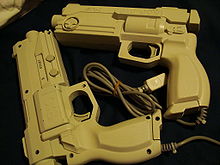
The Dreamcast is a home video game console released by Sega on November 27, 1998, in Japan; September 9, 1999, in North America; and October 14, 1999, in Europe. It was the first sixth-generation video game console, preceding Sony's PlayStation 2, Nintendo's GameCube, and Microsoft's Xbox. The Dreamcast was Sega's final console; its 2001 discontinuation ended the company's eighteen years in the console market.
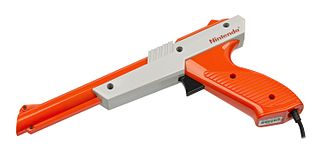
A light gun is a pointing device for computers and a control device for arcade and video games, typically shaped to resemble a pistol.

A game controller, gaming controller, or simply controller, is an input device or input/output device used with video games or entertainment systems to provide input to a video game. Input devices that have been classified as game controllers include keyboards, mice, gamepads, and joysticks, as well as special purpose devices, such as steering wheels for driving games and light guns for shooting games. Controllers designs have evolved to include directional pads, multiple buttons, analog sticks, joysticks, motion detection, touch screens and a plethora of other features.

Microsoft SideWinder was the general name given to the family of digital game controllers developed by Microsoft for PCs. The line was first launched in 1995. Although intended only for use with Microsoft Windows, Microsoft SideWinder game controllers can also be used with macOS, Mac OS 9 with third-party software, and Linux.

The Visual Memory Unit (VMU), also referred to as the Visual Memory System (VMS) in Japan and Europe, is the primary memory card produced by Sega for the Dreamcast home video game console. The device features a monochrome liquid crystal display (LCD), multiplayer gaming capability, second screen functionality, a real-time clock, file manager, built-in flash memory, and sound capability. Prior to the launch of the Dreamcast, a special Godzilla edition VMU, preloaded with a virtual pet game, was released on July 30, 1998, in Japan.
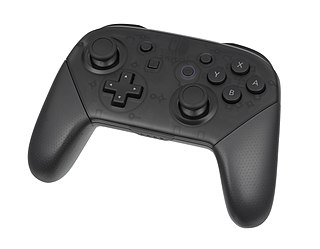
A gamepad is a type of video game controller held in two hands, where the fingers are used to provide input. They are typically the main input device for video game consoles.

A dance pad, also known as a dance mat or dance platform, is a flat electronic game controller used for input in dance games. Most dance pads are divided into a 3×3 matrix of square panels for the player to stand on, with some or all of the panels corresponding to directions or actions within the game. Some dance pads also have extra buttons outside the main stepping area, such as "Start" and "Select". Pairs of dance pads often are joined, side by side, for certain gameplay modes.

Street Fighter Alpha 3, released as Street Fighter Zero 3 in Japan, Asia, South America, and Oceania, is a 2D fighting game originally released by Capcom for the arcade in 1998. It is the third and final installment in the Street Fighter Alpha sub-series, which serves as a sequel to Street Fighter Alpha 2, and ran on the same CP System II hardware as previous Alpha games. The game was produced after the Street Fighter III sub-series has started, being released after 2nd Impact, but before 3rd Strike. Alpha 3 further expanded the playable fighter roster from Street Fighter Alpha 2 and added new features such as selectable fighting styles called "isms".
The DualShock is a line of gamepads developed by Sony Interactive Entertainment for the PlayStation family of video game consoles. It is named for vibration-feedback and analog controls. It was introduced in November 1997 as a secondary peripheral for the first PlayStation console. The console's bundle was updated to include DualShock, and phase out the original PlayStation controller and the Dual Analog Controller. The DualShock is the best-selling gamepad of all time by units sold, excluding bundled controllers.
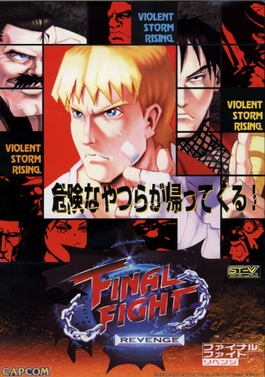
Final Fight Revenge is a 1999 3D fighting game released by Capcom. Revenge is the only one-on-one fighting game in the Final Fight series of games. The cast of playable characters includes series mainstays Mike Haggar, Cody and Guy, along with various members of the opposing Mad Gear gang. Originally developed for the Sega Saturn-based ST-V arcade hardware, a home version of Revenge for the Saturn only in Japan followed in 2000. A Dreamcast version was planned, but it was cancelled.

A D-pad is a flat, typically thumb-operated, directional control. D-Pads are found on nearly all modern gamepads, handheld game consoles, and audiovisual device remote controls. Because they operate using four internal push-buttons, the vast majority of D-pads provide discrete, rather than continuous, directional options—typically limited to up, down, left, and right, and sometimes offering intermediate diagonals by means of two-button combinations.

An arcade controller is a collective set of input devices designed primarily for use in an arcade cabinet. A typical control set consists of a joystick and a number of push-buttons. Less common setups include devices such as trackballs or steering wheels. These devices are generally produced under the assumption that they will be used in commercial settings, such as in video arcades, where they may be heavily or roughly used. Durability is one of the distinguishing characteristics of "authentic" arcade parts when compared with numerous, low-cost arcade imitations designed for private use in the home.

The Nintendo 64 controller is the standard game controller for the Nintendo 64 home video game console. Manufactured and released by Nintendo on June 23, 1996, in Japan; in September 29, 1996, in North America; and March 1, 1997, in Europe, it is the successor to the Super Nintendo controller and is designed in an "M" shape and features 10 buttons, one analog "Control Stick" and a directional pad.
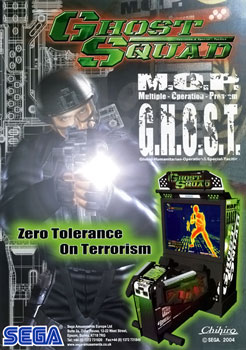
Ghost Squad and Ghost Squad: Evolution are light gun rail shooter arcade games developed and published by Sega. A home version of the original Ghost Squad was developed for Nintendo's Wii game console. A sequel, Operation GHOST, was released in arcades in 2012.

The GunCon, known as the G-Con in Europe, is a family of gun peripherals designed by Namco for the PlayStation consoles. The original controllers used traditional light gun technology, while newer controllers use LED tracking technology.

The Dreamcast VGA Box is an accessory for Sega's Dreamcast video game console that allows it to connect to a video display such as a computer monitor or an HDTV set through a VGA port. Because the Dreamcast hardware can produce a VGA-compatible video signal natively, this connection provides improved picture quality compared to standard composite video or S-Video connections, along with support for progressive scan video.
Rhythm game accessories are often required to play rhythm games available for various consoles, such as the PlayStation 2, PlayStation 3, Wii, and Xbox 360. These include dance pads, guitar controllers, drum controllers, microphones and turntable controllers. With the exception of microphones, these controllers can generally be used to control any game, but have limited inputs, making them impractical for most games.
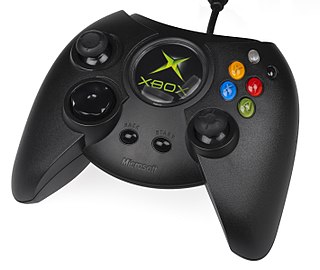
The Xbox controller is the primary game controller for Microsoft's Xbox home video game console and was introduced at the Game Developers Conference in 2000. The first-generation Xbox controller was the first controller bundled with Xbox systems for all territories except Japan. A smaller and redesigned variant, called "Controller S", was sold and bundled with the console in Japan. It was later released in other territories and by the end of 2003 had replaced the first-generation controller worldwide. The larger original controller remained available as an optional accessory.


